A Project of the Hudson River Estuary Program
Compiled and edited by Tom Lake, Consulting Naturalist
Love Our NY Lands
State Lands Belong to All of Us
All New Yorkers and visitors should be able to access, enjoy, and feel welcome on state lands. These lands belong to all of us, our families, and our neighbors. While enjoying these shared spaces, be respectful of other visitors. Share trails, treat people with kindness, and leave things as you found them for others to enjoy. All of us have a responsibility to protect State lands for future generations. For more information, visit DEC's website.
Overview
In an era that features the here-and-now, we love to post entries that take us back to earlier times in the Hudson Valley, reminding us of its tremendous time depth. In this instance, the measure of time, back to Colonial America, comes in the form of tree rings. With winter approaching, our educational seining for the year had all but ended. In the forests, a species of songbird was sighted for the first time in 40 years.
Highlight of the Week
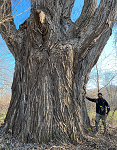 12/7 – Rensselaer County, HRM 167: In the rural outskirts of Rensselaer County, along the Hudson River in Schaghticoke, an enormous eastern cottonwood rests in a floodplain, outstretching its branches toward the Hudson River and blending into the surrounding canopy of trees. 12/7 – Rensselaer County, HRM 167: In the rural outskirts of Rensselaer County, along the Hudson River in Schaghticoke, an enormous eastern cottonwood rests in a floodplain, outstretching its branches toward the Hudson River and blending into the surrounding canopy of trees.
Those who drive past might not notice it, but for arborist Fred Breglia, the town’s primeval tree is a dream come true. Fred Breglia and his wife Erin Breglia measured, with a circumference of about 34 feet, what they believe is the largest documented tree in New York State and has the potential to be crowned the largest of its species in the world.
As he and his wife determined with a laser tree measurement tool, the tree stands roughly 108 feet tall, extending its branches of winter buds into the sky. He estimates it to be between 200 to 300 years old, but closer to the latter — a testament to its strength as it's a fast-growing but short-lived species that typically only survives 70 to 100 years on average. Despite its old age, the tree is still alive and surprisingly healthy, the forester said. (Photo of giant cottonwood with permission by Fred Breglia)
- Melissa Manno (Albany Times Union)
Natural History Entries
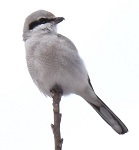 12/2 – Ulster County, HRM 71: Susan Logan Ward discovered a loggerhead shrike (Lanius ludovicianus) today at the Shawangunk Grasslands National Wildlife Refuge in Galeville. It had been 40 years since the last one was seen in Ulster County. If you see a northern shrike, always a good find in our region, make sure of your identification because there is a very similar-looking loggerhead shrike around. 12/2 – Ulster County, HRM 71: Susan Logan Ward discovered a loggerhead shrike (Lanius ludovicianus) today at the Shawangunk Grasslands National Wildlife Refuge in Galeville. It had been 40 years since the last one was seen in Ulster County. If you see a northern shrike, always a good find in our region, make sure of your identification because there is a very similar-looking loggerhead shrike around.
This could be the winter that Ulster County has both shrikes, loggerhead and northern (L. borealis) present. We are hoping that Galeville will have at least one shrike present for the New York State Minnewaska-Shawangunk Christmas Bird Count on 12/31. (Photo of loggerhead shrike courtesy of Peter Heidrich)
- Mark DeDea (Mid-Hudson Birds)
[The loggerhead shrike is a native, endemic, boreal songbird (passerine perching bird) whose presence in the Hudson Valley is extremely uncommon to rare. They are a “black-masked bandit” of open areas with bushes and trees. Their bold black, white, and gray pattern is distinctive; also note the stout hooked bill. The loggerhead shrike is widespread in southern and western North America, but never abundant, and declining over much of range.
They have a raptor-like appearance and will often display or impale their prey, such as smaller songbirds, on thorns or barbed wire. This has earned them their genus name Lanius, Latin for “butcher.” The species name of their very close relative, the northern shrike (L. borealis), translates from Latin as “butcher of the north.”
They expanded east by the 1870s and may have nested in Dutchess County in the 1890s. However, most records appear to be during migration with the majority occurring after 1950. The loggerhead shrike no longer breeds north or east of Dutchess County. eBird; Stan DeOrsey]
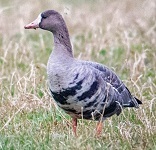 12/3 – Orange County, HRM 41: My first goal of the day was to try and track down the greater white-fronted goose originally located five days earlier by Ronnie DiLorenzo. I went to Wickham Lake, but all the geese were picking up and heading out. After unsuccessfully looking elsewhere, I went back to State School Road in Warwick and, sure enough, the greater white-fronted goose was present, up front in a flock of geese and looking beautiful. For me it was an Orange County year-bird for 2022. 12/3 – Orange County, HRM 41: My first goal of the day was to try and track down the greater white-fronted goose originally located five days earlier by Ronnie DiLorenzo. I went to Wickham Lake, but all the geese were picking up and heading out. After unsuccessfully looking elsewhere, I went back to State School Road in Warwick and, sure enough, the greater white-fronted goose was present, up front in a flock of geese and looking beautiful. For me it was an Orange County year-bird for 2022.
Later, I found an orange-crowned warbler (Leiothlypis celataon) on a trail at the Newburgh waterfront. I was excited because it was an Orange County life-bird for me, as well as a year-bird for 2022. (Photo of greater white-fronted goose courtesy of Matt Zeitler)
- Matt Zeitler
[The greater white-fronted goose (Anser albifrons), an Arctic breeder, appears once or twice in our area most years during the fall or winter. They are usually found in large flocks of Canada geese, a reward for the patient birder who checks them carefully. Barbara Butler, Ralph T. Waterman Bird Club]
[A “life bird” (or a “life list”) is a common activity for many naturalists. Typically, these are compilations of related species, like postcards from one’s travel through life. Some people keep bird lists; for others, it is fish, flowers, butterflies, mushrooms, sea-shells. Anyone can keep a list of almost anything that ultimately gives them a context and appreciation for the natural world. Tom Lake]
12/4 – Hook Mountain, HRM 31: Among the eight south-migrating raptors we counted today at the Hook Mountain Hawkwatch, red-tailed hawk with high count with four. The others were bald eagle and red-shouldered hawk with two each. Turkey vulture (13) showed well.
For non-raptor migrants, we had modest skeins of Canada geese (150+) and likely more, very distant, besides those roughly counted. Five double-crested cormorant moved south over the river. There were some other extremely distant larger birds, including presumed geese, too far for even our scope to pick up any detail.
- Tom Fiore
*** Fish of the Week ***
 12/5 – Hudson River Watershed: Fish-of-the-Week for Week 199 is the Atlantic moonfish (Selene setapinnis), number 177 (of 237), on our Hudson River Watershed List of Fishes. If you would like a copy of our list, e-mail: trlake7@aol.com 12/5 – Hudson River Watershed: Fish-of-the-Week for Week 199 is the Atlantic moonfish (Selene setapinnis), number 177 (of 237), on our Hudson River Watershed List of Fishes. If you would like a copy of our list, e-mail: trlake7@aol.com
[The Atlantic moonfish is one of six members of the jack family (Carangidae) documented for our watershed. Others include the round scad, crevalle jack, lookdown, banded rudderfish, and permit. All are considered temperate marine strays. Some ichthyologists, however, contend that the crevalle jack appears to have become a bit more established, and less of a stray, in the coastal waters of the New York Bight. Moonfish are found in Atlantic coastal waters from Cape Cod to Uruguay, but uncommon north of Chesapeake Bay. They can reach ten inches long and feed on small fishes and crustaceans
Moonfish get their name from their profile, a bright silvery-white rhombus that looks to some like a full moon, or to others as a shiny new silver quarter. They have the undeniable look of a tropical fish, one that is designed to escape predators by speed rather than concealment. They are a yellowish color, silvery, with a blue tinge. Moonfish have a nearly vertical facial profile with a blunt snout. Their body is very deep making them a strongly compressed fish with a deeply forked caudal fin and a narrow caudal peduncle.
Adults are found in coastal marine waters; young-of-year are frequently found on muddy bottoms in brackish-water estuaries. They are occasional late summer and early autumn visitor to the lower, estuary. There is only a scattering of records of young-of-year moonfish (c. 35-55 mm) in the last fifty years. The two most recent were October 3, 2008 (50 mm), at Englewood, NJ (Chris Letts-Tom Lake), and November 5, 2010 (35 mm) at Alpine, NJ (Margie Turin). (Photo of Atlantic moonfish with permission by New Jersey DEP)
- Tom Lake
[Note: One inch equals 25.4 millimeters (mm)].
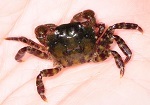 12/5 – Manhattan, HRM 1-2: Hudson River Park’s River Project staff checked our research gear (pots and traps) that we deploy at Piers 26 and 40 as part of our fish ecology survey. At Pier 26, two minnow pots caught a skilletfish and a young-of-year black sea bass (both 55 mm). Mud dog whelk snails, grass shrimp, and mud crabs helped fill pots and traps. 12/5 – Manhattan, HRM 1-2: Hudson River Park’s River Project staff checked our research gear (pots and traps) that we deploy at Piers 26 and 40 as part of our fish ecology survey. At Pier 26, two minnow pots caught a skilletfish and a young-of-year black sea bass (both 55 mm). Mud dog whelk snails, grass shrimp, and mud crabs helped fill pots and traps.
At Pier 40, our traps were empty of fish, but our staff found two common spider crabs in a crab pot, one male and one female, as well as an invasive Pacific (Asian) shore crab (Hemigrapsus sanguineus). (Photo of Asian shore crab courtesy of Tom Lake)
- Zoe Kim
12/6 – Town of Wappinger, HRM 67: In the fading light of late afternoon, we saw the silhouettes of both adults from bald eagle nest NY459, known to nest watchers as the “Bridge Nest.” They were perched near the crown of a tall black locust looming over the tidewater Wappinger Creek. This was the first time we had seen them together since they fledged a pair of nestlings in June.
- Judy Winter, Tom Lake
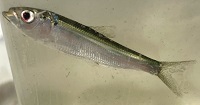 12/6 – Yonkers, HRM 18: With the warm-water season nearing an end, our staff at the Sarah Lawrence Center for the Urban River at Beczak made six hauls of our seine today. The always reliable Atlantic silverside was high count with seven (70 millimeters average length). Our resident killifish (mummichog) was next with five. 12/6 – Yonkers, HRM 18: With the warm-water season nearing an end, our staff at the Sarah Lawrence Center for the Urban River at Beczak made six hauls of our seine today. The always reliable Atlantic silverside was high count with seven (70 millimeters average length). Our resident killifish (mummichog) was next with five.
The highlight of our catch were two young-of-year-fishes heading in opposite directions: striped bass (100 mm) were heading toward the sea and Atlantic herring (70 mm) were nosing into the estuary as part of their autumn coastal spawning migration. The water temperature was 48 degrees Fahrenheit (F), salinity was 8.2 parts-per-thousand (ppt), and the dissolved oxygen (DO) was a healthy 10.1 parts-per-million (ppm). (Photo of Atlantic herring courtesy of Marisa Lynn Annuziato)
- Jason Muller, Rachel Lynch
12/7 – Hudson River Watershed: Among indigenous peoples, full moons have long been labeled with fanciful names that are rooted in oral traditions, indigenous memories, and ethnographic accounts.
Among Mohican people, whose ancestral homeland lies wholly within the Hudson River watershed, the December full moon is known as The Long Night Moon (Kwne tpoʔkut Neepã) in the Mohican dialect. This observation validates an ancestral recognition of the Winter Solstice.
Tribal translations of full moons pre-date colonization and generally reflect the seasonality of the lunar phase. Moon phases, in fact, were used by indigenous people as measurements of time.
- Larry Madden, Stockbridge-Munsee Band of Mohican Indians
 12/7 – Greene County: We anticipated a rare astronomical event tonight, a lunar occultation of Mars by the full moon. Occultation occurs when one celestial object is hidden from the observer by another celestial object that passes between them. In this instance, the moon passed between Earth and Mars. 12/7 – Greene County: We anticipated a rare astronomical event tonight, a lunar occultation of Mars by the full moon. Occultation occurs when one celestial object is hidden from the observer by another celestial object that passes between them. In this instance, the moon passed between Earth and Mars.
Unfortunately, clouds obscured our viewing from the Catskill Mountains. Fortunately, Reuben Mow of Ulster Park, managed to photograph the moon visually “kissing” the moon’s rim, a wonderfully precise alignment, as Mars disappeared behind the moon for a better part of an hour. A good friend in England (Kent, UK) sent me photos as he managed to see it in the predawn of December 8.
Both planets and the moon were all moving at considerable speeds in each of their unique orbits which makes this alignment amazing. It also happens that Mars was in “opposition,” which occurs when a planet is on the opposite side of earth from the sun making a full 180-degree reflection of the sun’s light. This makes the red planet the brightest it will be until the 2030’s. It is worth taking the time to look for Mars on clear nights thru the Holidays. (Photo of full moon courtesy of John Menz)
- Mario Meier
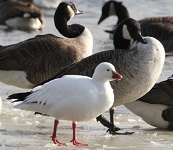 12/7 – Ulster County, HRM 82: This will be the winter for both shrike species (Lanius) in Ulster County! (See 12/2–Ulster County for an earlier shrike sighting.) Dave Nyzio photographed a northern shrike in Kripplebush today. 12/7 – Ulster County, HRM 82: This will be the winter for both shrike species (Lanius) in Ulster County! (See 12/2–Ulster County for an earlier shrike sighting.) Dave Nyzio photographed a northern shrike in Kripplebush today.
Peter Schoenberger, however, had the bird of the day with an afternoon discovery of a Ross's goose (Anser rossii) on Mill Dam Pond in Stone Ridge. Let's hope both birds stay right where they are until December 17 and can be counted on the Mohonk Lake/Ashokan Reservoir Christmas Bird Count. (Photo of Ross's goose courtesy of Rich Guthrie)
- Mark DeDea
[Roger Tory Peterson cites the Ross’s goose’s native range as the Pacific northwest and Canada, and wintering in central California, though they have become established in Texas as well. Ross’s geese breed in the Canadian arctic; the exact location was not discovered until 1938. A few turn up in the East, normally with snow geese, with which they hybridize. The first sighting of a Ross’s goose in New York State, where they are considered rare, was in1983 at Round Pond, Amenia, in Dutchess County. The bird was in company with two immature snow geese, two white-fronted geese, and 3,000+ Canada geese. There have been two further potential Ross’s goose sightings, also at Round Pond, in 1994 and 2008. New York State Avian Records Committee; The Birds of Dutchess County, Stan DeOrsey, and Barbara Butler]
 12/7 – Orange County, HRM 59: With the hourglass for seining about empty, we tried a west side beach at Kowawese looking for some river life. The river was a chilly-to-the-touch 46 degrees F with no salinity. Despite a south wind, pushing soft rollers up on the beach, Storm King Mountain was eerily shrouded in fog and mist. After many empty seine hauls, we managed to catch three spottail shiners 65-78 mm. These are a native, a very local species. They tend to be the first fish we see each spring and the final fish we see in late autumn. And, so it was. (Photo of spottail shiner with permission by University of Illinois) 12/7 – Orange County, HRM 59: With the hourglass for seining about empty, we tried a west side beach at Kowawese looking for some river life. The river was a chilly-to-the-touch 46 degrees F with no salinity. Despite a south wind, pushing soft rollers up on the beach, Storm King Mountain was eerily shrouded in fog and mist. After many empty seine hauls, we managed to catch three spottail shiners 65-78 mm. These are a native, a very local species. They tend to be the first fish we see each spring and the final fish we see in late autumn. And, so it was. (Photo of spottail shiner with permission by University of Illinois)
- Tom Lake, Phyllis Lake
[Spottail shiner (Notropis hudsonius), a native Hudson River fish, is one of 32 species of carps and minnows (Cyprinidae), the largest family of fishes in the watershed. Spottail shiner was described to science by DeWitt Clinton in 1824, between his two terms as the sixth and eighth governor of New York State (1817-1822, 1825-1828). Tom Lake]
12/7 – Manhattan, HRM 1-2: Our Hudson River Park River Project staff checked our traps and pots deployed at piers 26 and 40 today as part of our fish ecology survey.
At Pier 26, two minnow pots caught a skilletfish and a young-of-year black sea bass, both 55 mm. Mud dog snails, grass shrimp and mud crabs were all found at this location. At Pier 40, our traps were empty of fish, but our staff found two spider crabs in a crab pot, one male and one female. Additionally, an invasive Pacific shore crab was found in a minnow pot.
- Zoe Kim
12/8 – Hook Mountain, HRM 31: Across nearly five hours today, we counted a single south-migrating raptor, a red-shouldered hawk, at the Hook Mountain Hawkwatch. We saw no movement until near midday when a few turkey vultures finally lifted off from their night roosts. In early afternoon the eagles began showing up. First two second-year birds flew up just west of the Hook and drifted due north over Hemlock Hill. Then three more, an adult and two second-year birds, followed a similar path. None were deemed to be migrating. If this was a spring day, it would have been a good eagle count. Just the one red-tailed hawk was seen in a continuing flight due west and was counted as a migrant.
- Trudy Battaly, Drew Panko, Raimund Miller, Tom Fiore
 12/8 – Yonkers, HRM 18: Our staff at the Sarah Lawrence Center for the Urban River at Beczak made our final five seine hauls of the season today. Our catch was dominated by young-of-year fishes, including Atlantic silverside, Atlantic menhaden, Atlantic herring, and striped bass. Among invertebrates were sand shrimp and moon jellyfish. 12/8 – Yonkers, HRM 18: Our staff at the Sarah Lawrence Center for the Urban River at Beczak made our final five seine hauls of the season today. Our catch was dominated by young-of-year fishes, including Atlantic silverside, Atlantic menhaden, Atlantic herring, and striped bass. Among invertebrates were sand shrimp and moon jellyfish.
The water temperature was 48 degrees F, salinity was 9.0 ppt, and the dissolved oxygen (DO) was a healthy 9.1 ppm. (Photo of Atlantic menhaden courtesy of Tom Lake)
- Jason Muller, Christina Edsall, Katie Lamboy, Ishika Joshi
12/9 – Hook Mountain, HRM 31: It was a very short visit, less than an hour, but well worth the climb to the Hook Mountain Hawkwatch summit. Of the three migrating raptors, red-tailed hawk, golden eagle, and one unidentified falcon had one-each. Black vulture (9) and turkey vulture (7) were collectively the numerical high count among non-raptor migrants.
The first migrants were a pair of black vultures and then a local immature bald eagle was spotted among a kettle of turkey vultures over the river to the southeast. Moments later, another kettle came up northeast of the watch that included a golden eagle with unmistakable first-year plumage, our eighth golden eagle of the season. The golden came directly over the watch and gave us a great look before taking off west-southwest where it was harassed by an unidentified falcon (the sun was setting, making distant birds in that direction difficult to ID). Both continued west-southwest.
- Eugene Gardner

Winter 2022 Natural History Programs and Events
Women in Science
Please join the DEC’s Hudson River Estuary Program’s free virtual Women in Science series this winter. Meet and learn from scientists, community leaders, and environmental educators who work at the intersection of research, education, and environmental and social justice. Engage in discussions about data literacy, sea level rise and sediment accumulation, wetland restoration, oysters, and field-based research. For information and how to register visit here.
Hudson River Education
Teachers and students will enjoy our new Hudson River K-12 Unit of Study. This carefully curated group of lesson plans, arranged by topic and/or grade, brings together great learning tools developed by the DEC and dozens of estuary partners.
Hudson River Miles
The Hudson is measured north from Hudson River Mile 0 at the Battery at the southern tip of Manhattan. The George Washington Bridge is at HRM 12, the Tappan Zee 28, Bear Mountain 47, Beacon-Newburgh 62, Mid-Hudson 75, Kingston-Rhinecliff 95, Rip Van Winkle 114, and the Federal Dam at Troy, the head of tidewater, at 153. The tidal section of the Hudson constitutes a bit less than half the total distance – 315 miles – from Lake Tear of the Clouds to the Battery. Entries from points east and west in the watershed reference the corresponding river mile on the mainstem.
To Contribute Your Observations or to Subscribe
The Hudson River Almanac is compiled and edited by Tom Lake and emailed weekly by DEC's Hudson River Estuary Program. Share your observations by e-mailing them to trlake7@aol.com. To subscribe to the Almanac (or to unsubscribe), use the links on DEC's Hudson River Almanac or DEC Delivers web pages.
Useful Links
National Oceanic and Atmospheric Administration online tide and tidal current predictions are invaluable when planning Hudson River field trips. For real-time information on Hudson River tides, weather, and water conditions from sixteen monitoring stations, visit the Hudson River Environmental Conditions Observing System website.
DEC's Smartphone app for iPhone and Android is now available at New York Fishing, Hunting & Wildlife App.
|


 12/7 – Rensselaer County, HRM 167: In the rural outskirts of Rensselaer County, along the Hudson River in Schaghticoke, an enormous eastern cottonwood rests in a floodplain, outstretching its branches toward the Hudson River and blending into the surrounding canopy of trees.
12/7 – Rensselaer County, HRM 167: In the rural outskirts of Rensselaer County, along the Hudson River in Schaghticoke, an enormous eastern cottonwood rests in a floodplain, outstretching its branches toward the Hudson River and blending into the surrounding canopy of trees. 12/2 – Ulster County, HRM 71: Susan Logan Ward discovered a loggerhead shrike (Lanius ludovicianus) today at the Shawangunk Grasslands National Wildlife Refuge in Galeville. It had been 40 years since the last one was seen in Ulster County. If you see a northern shrike, always a good find in our region, make sure of your identification because there is a very similar-looking loggerhead shrike around.
12/2 – Ulster County, HRM 71: Susan Logan Ward discovered a loggerhead shrike (Lanius ludovicianus) today at the Shawangunk Grasslands National Wildlife Refuge in Galeville. It had been 40 years since the last one was seen in Ulster County. If you see a northern shrike, always a good find in our region, make sure of your identification because there is a very similar-looking loggerhead shrike around. 12/3 – Orange County, HRM 41: My first goal of the day was to try and track down the greater white-fronted goose originally located five days earlier by Ronnie DiLorenzo. I went to Wickham Lake, but all the geese were picking up and heading out. After unsuccessfully looking elsewhere, I went back to State School Road in Warwick and, sure enough, the greater white-fronted goose was present, up front in a flock of geese and looking beautiful. For me it was an Orange County year-bird for 2022.
12/3 – Orange County, HRM 41: My first goal of the day was to try and track down the greater white-fronted goose originally located five days earlier by Ronnie DiLorenzo. I went to Wickham Lake, but all the geese were picking up and heading out. After unsuccessfully looking elsewhere, I went back to State School Road in Warwick and, sure enough, the greater white-fronted goose was present, up front in a flock of geese and looking beautiful. For me it was an Orange County year-bird for 2022. 12/5 – Hudson River Watershed: Fish-of-the-Week for Week 199 is the Atlantic moonfish (Selene setapinnis), number 177 (of 237), on our Hudson River Watershed List of Fishes. If you would like a copy of our list, e-mail:
12/5 – Hudson River Watershed: Fish-of-the-Week for Week 199 is the Atlantic moonfish (Selene setapinnis), number 177 (of 237), on our Hudson River Watershed List of Fishes. If you would like a copy of our list, e-mail:  12/5 – Manhattan, HRM 1-2: Hudson River Park’s River Project staff checked our research gear (pots and traps) that we deploy at Piers 26 and 40 as part of our fish ecology survey. At Pier 26, two minnow pots caught a skilletfish and a young-of-year black sea bass (both 55 mm). Mud dog whelk snails, grass shrimp, and mud crabs helped fill pots and traps.
12/5 – Manhattan, HRM 1-2: Hudson River Park’s River Project staff checked our research gear (pots and traps) that we deploy at Piers 26 and 40 as part of our fish ecology survey. At Pier 26, two minnow pots caught a skilletfish and a young-of-year black sea bass (both 55 mm). Mud dog whelk snails, grass shrimp, and mud crabs helped fill pots and traps. 12/6 – Yonkers, HRM 18: With the warm-water season nearing an end, our staff at the Sarah Lawrence Center for the Urban River at Beczak made six hauls of our seine today. The always reliable Atlantic silverside was high count with seven (70 millimeters average length). Our resident killifish (mummichog) was next with five.
12/6 – Yonkers, HRM 18: With the warm-water season nearing an end, our staff at the Sarah Lawrence Center for the Urban River at Beczak made six hauls of our seine today. The always reliable Atlantic silverside was high count with seven (70 millimeters average length). Our resident killifish (mummichog) was next with five. 12/7 – Greene County: We anticipated a rare astronomical event tonight, a lunar occultation of Mars by the full moon. Occultation occurs when one celestial object is hidden from the observer by another celestial object that passes between them. In this instance, the moon passed between Earth and Mars.
12/7 – Greene County: We anticipated a rare astronomical event tonight, a lunar occultation of Mars by the full moon. Occultation occurs when one celestial object is hidden from the observer by another celestial object that passes between them. In this instance, the moon passed between Earth and Mars. 12/7 – Ulster County, HRM 82: This will be the winter for both shrike species (Lanius) in Ulster County! (See 12/2–Ulster County for an earlier shrike sighting.) Dave Nyzio photographed a northern shrike in Kripplebush today.
12/7 – Ulster County, HRM 82: This will be the winter for both shrike species (Lanius) in Ulster County! (See 12/2–Ulster County for an earlier shrike sighting.) Dave Nyzio photographed a northern shrike in Kripplebush today. 12/7 – Orange County, HRM 59: With the hourglass for seining about empty, we tried a west side beach at Kowawese looking for some river life. The river was a chilly-to-the-touch 46 degrees F with no salinity. Despite a south wind, pushing soft rollers up on the beach, Storm King Mountain was eerily shrouded in fog and mist. After many empty seine hauls, we managed to catch three spottail shiners 65-78 mm. These are a native, a very local species. They tend to be the first fish we see each spring and the final fish we see in late autumn. And, so it was. (Photo of spottail shiner with permission by University of Illinois)
12/7 – Orange County, HRM 59: With the hourglass for seining about empty, we tried a west side beach at Kowawese looking for some river life. The river was a chilly-to-the-touch 46 degrees F with no salinity. Despite a south wind, pushing soft rollers up on the beach, Storm King Mountain was eerily shrouded in fog and mist. After many empty seine hauls, we managed to catch three spottail shiners 65-78 mm. These are a native, a very local species. They tend to be the first fish we see each spring and the final fish we see in late autumn. And, so it was. (Photo of spottail shiner with permission by University of Illinois) 12/8 – Yonkers, HRM 18: Our staff at the Sarah Lawrence Center for the Urban River at Beczak made our final five seine hauls of the season today. Our catch was dominated by young-of-year fishes, including Atlantic silverside, Atlantic menhaden, Atlantic herring, and striped bass. Among invertebrates were sand shrimp and moon jellyfish.
12/8 – Yonkers, HRM 18: Our staff at the Sarah Lawrence Center for the Urban River at Beczak made our final five seine hauls of the season today. Our catch was dominated by young-of-year fishes, including Atlantic silverside, Atlantic menhaden, Atlantic herring, and striped bass. Among invertebrates were sand shrimp and moon jellyfish.